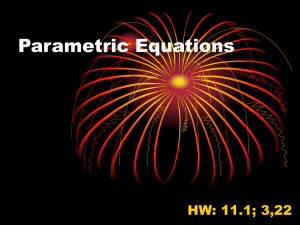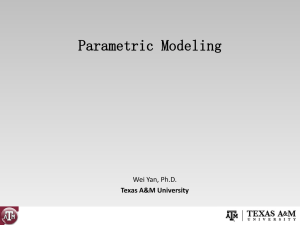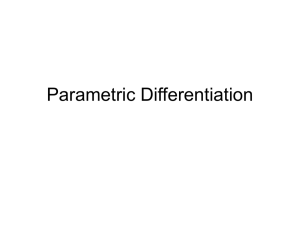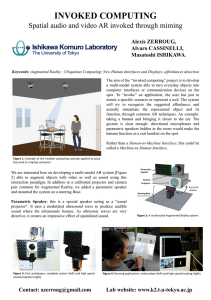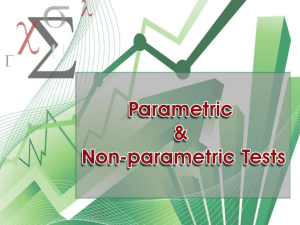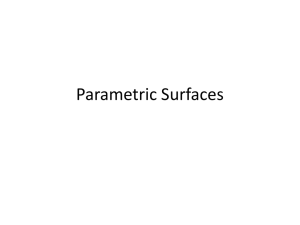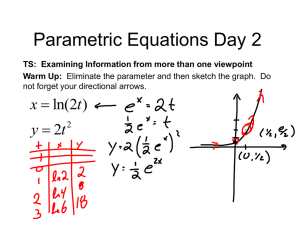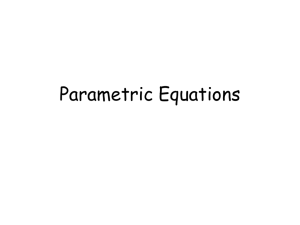RV: A Runtime Verification Framework for Monitoring, Prediction and
advertisement
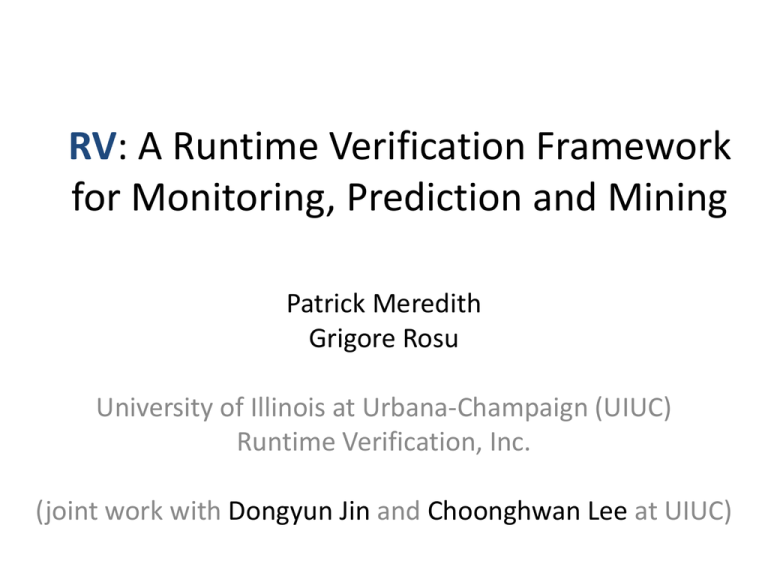
RV: A Runtime Verification Framework for Monitoring, Prediction and Mining Patrick Meredith Grigore Rosu University of Illinois at Urbana-Champaign (UIUC) Runtime Verification, Inc. (joint work with Dongyun Jin and Choonghwan Lee at UIUC) Assurances for Self-Adaptive Systems • Self-adaptive systems come with new challenges – Increased complexity – Reasoning in the presence of uncertainty – System analysis pushed to a whole new dimension • Concerned not only with functional correctness of the system, but also with how system changes/adapts –… • This talk focuses on a very limited related aspect – How to specify a subset of essentially dynamic properties and how to efficiently runtime verify and validate them Runtime Verification (RV) • Observe the system while it executes, possibly after appropriate instrumentation • Check the observed behavior against desirable explicit or implicit properties • React to detected violations – Report error , if used before deployment – Recover (when possible), during deployment RV Workshop/Conference • Runtime verification had a hard time initially – Not testing, not verification; what it is? • Started in 2001 as workshop, about 20 people – ENTCS proceedings – Selected papers in journal (FMSD) • Turned into a conference in 2010 – LNCS proceedings – FMSD special issue – 80 participants • RV’11 had ~80 submissions Current Limitations of Runtime Verification • Runtime and memory overhead: system observation and monitoring may add significant runtime and memory overhead • Limited coverage: if done naively, runtime verification guarantees lack of bugs only in the observed path, but not in other paths • Specifications: the difficulty of producing property specifications is underestimated. Developers do not want to write them. Overview • The RV system – Highlights and goals • Parametric properties – What they are, semantics and slicing • Underlying technologies of RV – Monitoring – Prediction – Mining • Conclusion The RV System • Developed by Runtime Verification, Inc., a startup company in Urbana, in collaboration with the Formal Systems Lab (FSL) at UIUC • Aims at overcoming the current limitations of runtime verification and, implicitly, at becoming the best runtime verification system • Builds upon technologies developed during the last 7 years within the FSL@UIUC How RV System Overcomes Current Limitations of Runtime Verification • Low runtime and memory overhead: efficient instrumentation; delay monitor creation; garbage collect monitors • Increase coverage: predictive runtime analysis used to analyze causal models instead of flat execution traces; causal models comprise many traces • Mine specifications: running and observing unit tests, it learns (1) the most likely interacting events, and (2) the most likely properties they obey RV System Overview RV Builds Upon UIUC Technologies • Efficient monitoring of parametric properties – JavaMOP • RV’03-10, TACAS’05, OOPSLA’07, ASE’08, ASE’09, PLDI’11 • Predictive runtime analysis – jPredictor • FSE’03, TACAS’04, FMOODS’05, CAV’07, SAS’07, ICSE’08 • Mining of parametric properties – jMiner • ICSE’11 RV at Work: Monitoring I • Consider the following (wrong) Java program: Wrong! • It modifies vector while enumerating it RV at Work: Monitoring II • Write parametric specifications under ./mop: instrumentation parameters property reaction RV at Work: Monitoring III • Then call RV on the Java program to monitor: • RV compiles the program (with javac), generates monitors as aspects, then weaves them within the program binary (with ajc), then runs the resulting programs RV at Work: Prediction I • Consider the following (wrong) Java program: Races • Program has a race on the i and a race on output; these races will most likely not appear during testing; RV can predict them from one “successful” execution RV at Work: Prediction II • By default, RV prediction searches for races: RV at Work: Prediction III • To predict violations of parametric properties, one needs to place them under ./mop, same like when monitoring them • A program may have races but those may not lead to violations of specifications – Though not a good idea to allow races anyway • Also, a program may run “successfully”, have no races predicted in it, but still violate behavioral specifications RV at Work: Mining • The RV miner is less obvious to use • It works in two stages: – First, it observes executions of (small and tricky) unit tests to learn groups of parameters and corresponding events that interact – Then it observes (large and likely correct) programs making use of the learned events and • It slices the observed (large) parametric traces into (typically lots of small) non-parametric traces • It learns non-parametric properties that best explain the computed slices • Then adds the learned parameters to them Parametric Properties • At the core of RV: all requirements are specified as parametric properties • These are properties over parametric events • Comprise a potentially unbounded number of property instances, one for each parameter • The main challenge is how to efficiently and correctly keep track of all property instances Examples of Parametric Properties I • Typestates are particular, one-parameter properties • For example, “hasnext() must be called and hold before each next() is called”, can be defined as follows: Examples of Parametric Properties II • Same “hasnext() must be called and hold before each next() is called” typestate property, but specified using different parametric variants: – As a parametric regular expression: – As a parametric linear temporal logic formula: Examples of Parametric Properties III • Colections are not allowed to change while accessed through iterators: • To avoid clutter, we drop the understood event parameters, i.e., we write the above as Examples of Parametric Properties IV • Authenticate each key before use: • Each function should release each lock as many times as it acquires it (this is a parametric context-free property): Parametric Trace Slicing I • RV is all about monitoring, predicting violations of, and mining parametric properties • All the above work with parametric traces – Traces formed with parametric events • Therefore, all face the problem of trace slicing – How to identify the sub-traces of events corresponding to each parameter instance? Parametric Trace Slicing II update(v1) updatesource(v1) v1, e2 updatesource updatesource updatesource(v2) trace slice CHALLENGE: updatesource How to do it efficiently? next create(v1,e2) updatesource(v1) next(e1) v2, e1 create create (v1,e1) next(e1) v1, e1 next create updatesource next For given parameters (v, e) next v2, e2 RV Monitoring • Sends each trace slice to one monitor instance • Problem: The number of slices can be huge (potentially unbounded) • Challenge: Manage monitors efficiently – Index them for efficient retrieval – Garbage collect them when become unnecessary Monitor Indexing • Indexing trees using weak references – One tree per parameter combination in events – Monitors are collected when no events available More Garbage Collection • Indexing trees alone not good enough • Pathological examples where unnecessary monitors stay alive forever • Solution: analyze the property statically; then collect monitors when they have no future RV Monitoring Performance Evaluation >2x faster than JavaMOP, >10x faster than Tracematches (A) Runtime overhead in % (B) Memory overhead in MB RV Prediction • Predicts errors in concurrent programs – Model checking: number of interleavings is prohibitively large – Testing: interleavings depend on environment • Combine dynamic and static methods to find bad behaviors near correct executions 29 29 Prediction Example 30 Prediction Example • Buggy S4 can be executed before S1 • Low likelyhood to hit error in testing 31 31 Predictive Runtime Analysis 32 Predictive Runtime Analysis 33 Predictive Runtime Analysis 34 Predictive Runtime Analysis 35 Happens-Before Works ... If Lucky 36 Happens-Before Works ... If Lucky 37 Happens-Before Limitations 38 RV Uses Sliced Causality • • • • Relaxes the Happens-Before causal model How? Focus on the property Use static information about the program Remove irrelevant events and causalities – Smaller and more relaxed causal model – (Exponentially) more inferred executions – Better predictive capability 39 39 Static Information: Control Scope • S2 is in the control scope of S1 if its execution depends on a choice at S1 • Extends to other control statements – break/continue, return, exceptions 40 40 Sliced Causality Works! 41 Slice Causality Works! 42 No False Alarms ☺ 43 No False Alarms ☺ 44 RV Prediction Performance RV Mining • RV monitoring slices parametric traces and sends each slice to a monitor instance • RV miner is dual to RV monitor: – It uses (almost) the same trace slicer, but instead of sending the slices to monitors, uses them as input to a regular property learner (PFSA) • This way, we were able to mine most of the parametric specifications that we previously used for monitoring RV Mining Example I Two properties in one: - the collection-iterator - the hasnext typestate RV Mining Example • Server socket parametric specification: RV Mining Preliminary Evaluation I • Used several packages that come with unit tests RV Mining Preliminary Evaluation II • Still relatively slow, though the mined specifications are very useful and general-purpose • Slicing is the most expensive Conclusion • The RV system combines monitoring, prediction and specification mining • Uses at its core the notion of parametric specification, together with algorithms for parametric trace slicing used across any of the monitoring, prediction and mining capabilities • RV shows that the three apparently different technologies, namely monitoring, prediction and mining, in fact belong together
